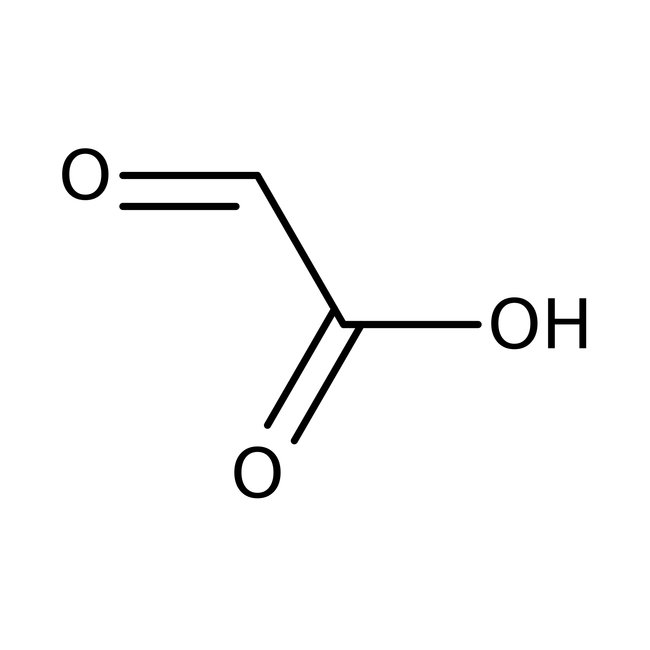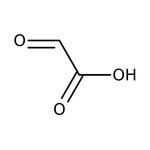Search Thermo Fisher Scientific
Thermo Scientific Chemicals
Glyoxylic acid, 50% w/w aq. soln.
CAS: 298-12-4 | C2H2O3 | 74.035 g/mol
Catalog number ALFB25149.30
View Price:Sign InSign in to see your account pricing. Need an account? Register with us today.
Quantity:
250 g
Specifications
Chemical Name or MaterialGlyoxylic acid
CAS298-12-4
Health Hazard 1H290-H314-H317-H318
Health Hazard 2GHS H Statement
H314-H317
Causes severe skin burns and eye damage.
May cause an allergic skin reaction.
H314-H317
Causes severe skin burns and eye damage.
May cause an allergic skin reaction.
Health Hazard 3P234-P260-P264b-P272-P280-P301+P330+P331-P303+P361+P353-P304+P340-P305+P351+P338-P310-P333+P313-P363-P501c
View more
Glyoxylic acid is used in Hopkins Cole reaction, which is used in the detection of tryptophan in proteins. It reacts with phenol to get 4-hydroxymandelic acid, which on further reaction with ammonia gives hydroxyphenylglycine, as a precursor to the drug amoxicillin. It is also used as a starting material for the preparation of 4-hydroxyphenylacetic acid, which is used to get atenolol. It is involved in the production of agrochemicals, aromas, cosmetic ingredient and pharmaceutical intermediate. It is also used in water purification and in the preservation of food. Further, it is employed as precursor in the synthesis of iron chelates. In addition to this, it serves as an intermediate of varnish material and dyes.
This Thermo Scientific Chemicals brand product was originally part of the Alfa Aesar product portfolio. Some documentation and label information may refer to the legacy brand. The original Alfa Aesar product / item code or SKU reference has not changed as a part of the brand transition to Thermo Scientific Chemicals.
Applications
Glyoxylic acid is used in Hopkins Cole reaction, which is used in the detection of tryptophan in proteins. It reacts with phenol to get 4-hydroxymandelic acid, which on further reaction with ammonia gives hydroxyphenylglycine, as a precursor to the drug amoxicillin. It is also used as a starting material for the preparation of 4-hydroxyphenylacetic acid, which is used to get atenolol. It is involved in the production of agrochemicals, aromas, cosmetic ingredient and pharmaceutical intermediate. It is also used in water purification and in the preservation of food. Further, it is employed as precursor in the synthesis of iron chelates. In addition to this, it serves as an intermediate of varnish material and dyes.
Solubility
Miscible with ethanol. Slightly miscible with ether and benzene. Immiscible with esters.
Notes
Incompatible with metals, alkalies, strong oxidizing agents and strong bases.
Glyoxylic acid is used in Hopkins Cole reaction, which is used in the detection of tryptophan in proteins. It reacts with phenol to get 4-hydroxymandelic acid, which on further reaction with ammonia gives hydroxyphenylglycine, as a precursor to the drug amoxicillin. It is also used as a starting material for the preparation of 4-hydroxyphenylacetic acid, which is used to get atenolol. It is involved in the production of agrochemicals, aromas, cosmetic ingredient and pharmaceutical intermediate. It is also used in water purification and in the preservation of food. Further, it is employed as precursor in the synthesis of iron chelates. In addition to this, it serves as an intermediate of varnish material and dyes.
Solubility
Miscible with ethanol. Slightly miscible with ether and benzene. Immiscible with esters.
Notes
Incompatible with metals, alkalies, strong oxidizing agents and strong bases.
RUO – Research Use Only
General References:
- For use in aqueous hetero Diels-Alder reactions, see: Tetrahedron, 50, 10265 (1994).
- Reagent for the facile deprotection of oximes in aqueous medium: Tetrahedron Lett., 45, 3161 (2004).
- Qin, W.; Guo, R. Metallization of polyester fabric by autocatalytic copper plating process using glyoxylic acid as a reducing agent. Fiber Polym. 2015, 16 (8), 1671-1675.
- Uslu, H.; Datta, D.; Kumar, S. Investigations on the Reactive Extraction of Glyoxylic Acid by Amberlite-LA2 Dissolved in Alcoholic Diluents. Sep. Sci. Technol. 2015, 50 (17), 2658-2667.



